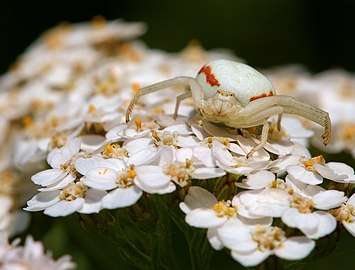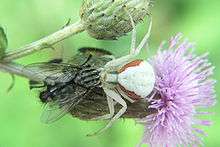Misumena
Misumena is a genus of crab spiders sometimes referred to as flower crab spiders.[1] They are similar in appearance to several other genera in the family Thomisidae, such as Misumenoides and Mecaphesa.[1]
| Misumena | |
|---|---|
 | |
| Misumena vatia female | |
| Scientific classification | |
| Kingdom: | Animalia |
| Phylum: | Arthropoda |
| Subphylum: | Chelicerata |
| Class: | Arachnida |
| Order: | Araneae |
| Infraorder: | Araneomorphae |
| Family: | Thomisidae |
| Genus: | Misumena Latreille, 1804 |
Misumena vatia, the goldenrod crab spider, is a North American species commonly seen hunting in goldenrod (Solidago) sprays in autumn. It can change its color between white and yellow to match the flower it is sitting on. The color change takes a few days.
Species

Misumena vatia with fly
As of 2008, the World Spider Catalog listed the following species:
- Misumena adelae Mello-Leitão, 1944 – Argentina
- Misumena alpha Chrysanthus, 1964 – New Guinea
- Misumena amabilis Keyserling, 1880 – Peru
- Misumena annapurna Tikader, 1963 – India
- Misumena arrogans Thorell, 1881 – Yule Island
- Misumena atrocincta Costa, 1875 – Egypt
- Misumena beta Chrysanthus, 1964 – New Guinea
- Misumena bicolor Simon, 1875 – Corsica
- Misumena bipunctata Rainbow, 1898 – Australia
- Misumena citreoides (Taczanowski, 1872) – Guyana, French Guiana
- Misumena conferta Banks, 1898 – Mexico
- Misumena fasciata Kulczynski, 1911 – New Guinea
- Misumena fidelis Banks, 1898 – United States, Mexico
- Misumena frenata Simon, 1909 – Vietnam
- Misumena ganpatii Kumari & Mittal, 1994 – India
- Misumena greenae Tikader, 1965 – India
- Misumena grubei (Simon, 1895) – Mongolia, China
- Misumena indra Tikader, 1963 – India
- Misumena innotata Thorell, 1881 – New Guinea
- Misumena lorentzi Kulczynski, 1911 – New Guinea
- Misumena luteovariata Mello-Leitão, 1929 – Brazil
- Misumena maputiyana Barrion & Litsinger, 1995 – Philippines
- Misumena maronica Caporiacco, 1954 – French Guiana
- Misumena mridulai Tikader, 1962 – India
- Misumena nana Lessert, 1933 – Angola
- Misumena nigripes (Taczanowski, 1872) – Peru, French Guiana
- Misumena nigromaculata Denis, 1963 – Madeira
- Misumena oblonga O. P.-Cambridge, 1885 – Yarkand
- Misumena pallescens Caporiacco, 1949 – Kenya
- Misumena peninsulana Banks, 1898 – Mexico
- Misumena picta Franganillo, 1926 – Cuba
- Misumena platimanu Mello-Leitão, 1929 – Brazil
- Misumena quadrivulvata Franganillo, 1926 – Cuba
- Misumena rubripes Keyserling, 1880 – Peru
- Misumena spinifera (Blackwall, 1862) – Madeira, Canary Islands
- Misumena spinigaster Mello-Leitão, 1929 – Brazil
- Misumena tapyasuka Barrion & Litsinger, 1995 – Java
- Misumena terrosa Soares, 1944 – Brazil
- Misumena variegata Keyserling, 1880 – Peru
- Misumena vatia (Clerck, 1757) – Holarctic
- Misumena vazquezae Jiménez, 1986 – Mexico
- Misumena viridans Mello-Leitão, 1917 – Brazil
- †Misumena samlandica Petrunkevitch, 1942 – Baltic amber
gollark: That is what I said, yes.
gollark: Oh, company, not flavour.
gollark: Liquiescent bee slurry and cheese?
gollark: Or the abstract graph rewriting engine.
gollark: They won't be able to compete with the GTech™ computational cuboids where everything is polygons instead.
References
- "Genus Misumena - Flower Crab Spiders - BugGuide.Net". bugguide.net. Retrieved 7 January 2020.
- Platnick, Norman I. (2008): The world spider catalog, version 8.5. American Museum of Natural History.
This article is issued from Wikipedia. The text is licensed under Creative Commons - Attribution - Sharealike. Additional terms may apply for the media files.